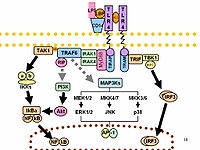
Allergic rhinitis, of which the seasonal type is called hay fever, is a type of inflammation in the nose that occurs when the immune system overreacts to allergens in the air. Signs and symptoms include a runny or stuffy nose, sneezing, red, itchy, and watery eyes, and swelling around the eyes. The fluid from the nose is usually clear. Symptom onset is often within minutes following allergen exposure, and can affect sleep and the ability to work or study. Some people may develop symptoms only during specific times of the year, often as a result of pollen exposure. Many people with allergic rhinitis also have asthma, allergic conjunctivitis, or atopic dermatitis.

In genetics and bioinformatics, a single-nucleotide polymorphism is a germline substitution of a single nucleotide at a specific position in the genome that is present in a sufficiently large fraction of considered population.

Atopy is the tendency to produce an exaggerated immunoglobulin E (IgE) immune response to otherwise harmless substances in the environment. Allergic diseases are clinical manifestations of such inappropriate, atopic responses.
In molecular biology, SNP array is a type of DNA microarray which is used to detect polymorphisms within a population. A single nucleotide polymorphism (SNP), a variation at a single site in DNA, is the most frequent type of variation in the genome. Around 335 million SNPs have been identified in the human genome, 15 million of which are present at frequencies of 1% or higher across different populations worldwide.
The common disease-common variant hypothesis predicts that common disease-causing alleles, or variants, will be found in all human populations which manifest a given disease. Common variants are known to exist in coding and regulatory sequences of genes. According to the CD-CV hypothesis, some of those variants lead to susceptibility to complex polygenic diseases. Each variant at each gene influencing a complex disease will have a small additive or multiplicative effect on the disease phenotype. These diseases, or traits, are evolutionarily neutral in part because so many genes influence the traits. The hypothesis has held in the case of putative causal variants in apolipoprotein E, including APOE ε4, associated with Alzheimer's disease. IL23R has been found to be associated with Crohn's disease; the at-risk allele has a frequency of 93% in the general population.

In genomics, a genome-wide association study, is an observational study of a genome-wide set of genetic variants in different individuals to see if any variant is associated with a trait. GWA studies typically focus on associations between single-nucleotide polymorphisms (SNPs) and traits like major human diseases, but can equally be applied to any other genetic variants and any other organisms.

CD6 is a human protein encoded by the CD6 gene.

C-type lectin domain family 16, also known as CLEC16A, is a protein that in humans is encoded by the CLEC16A gene.
The Center for Applied Genomics is a research center at the Children's Hospital of Philadelphia that focuses on genomics research and the utilization of basic research findings in the development of new medical treatments.

CDKN2B-AS, also known as ANRIL is a long non-coding RNA consisting of 19 exons, spanning 126.3kb in the genome, and its spliced product is a 3834bp RNA. It is located within the p15/CDKN2B-p16/CDKN2A-p14/ARF gene cluster, in the antisense direction. Single nucleotide polymorphisms (SNPs) which alter the expression of CDKN2B-AS are associated with human healthy life expectancy, as well as with multiple diseases, including coronary artery disease, diabetes and many cancers. It binds to chromobox 7 (CBX7) within the polycomb repressive complex 1 and to SUZ12, a component of polycomb repression complex 2 and through these interactions is involved in transcriptional repression.

A gene is said to be polymorphic if more than one allele occupies that gene's locus within a population. In addition to having more than one allele at a specific locus, each allele must also occur in the population at a rate of at least 1% to generally be considered polymorphic.
The missing heritability problem is the fact that single genetic variations cannot account for much of the heritability of diseases, behaviors, and other phenotypes. This is a problem that has significant implications for medicine, since a person's susceptibility to disease may depend more on the combined effect of all the genes in the background than on the disease genes in the foreground, or the role of genes may have been severely overestimated.

Phosphatase and actin regulator 1 (PHACTR1) is a protein that in humans is encoded by the PHACTR1 gene on chromosome 6. It is most significantly expressed in the globus pallidus of the brain. PHACTR1 is an actin and protein phosphatase 1 (PP1) binding protein that binds actin and regulates the reorganization of the actin cytoskeleton. This protein has been associated with coronary artery disease and migraines through genome-wide association studies. The PHACTR1 gene also contains one of 27 SNPs associated with increased risk of coronary artery disease.
Project MinE is an independent large scale whole genome research project that was initiated by 2 patients with amyotrophic lateral sclerosis and started on World ALS Day, June 21, 2013.
The GWAS catalog is a free online database that compiles data of genome-wide association studies (GWAS), summarizing unstructured data from different literature sources into accessible high quality data. It was created by the National Human Genome Research Institute (NHGRI) in 2008 and have become a collaborative project between the NHGRI and the European Bioinformatics Institute (EBI) since 2010. As of September 2018, it has included 71,673 SNP–trait associations in 3,567 publications.

N-Acetylated Alpha-Linked Acidic Dipeptidase Like 2 (NAALADL2) is a protein, encoded by the gene NAALADL2 in humans. NAALADL2 shares 25%–26% sequence identity and 45% sequence similarity with the glutamate carboxypeptidase II family which includes prostate cancer marker PSMA (FOLH1/NAALAD1). The NAALADL2 gene is a giant gene spanning 1.37 Mb which is approximately 49 times larger than the average gene size of 28 kb. Gene length is correlated with the number of transcript variants of a gene, as such, NAALADL2 undergoes extensive alternative splicing and has 12 splice variants as defined by Ensembl.

Stephanie J. London is an American epidemiologist and physician-scientist specializing in environmental health, respiratory diseases, and genetic susceptibility. She is the deputy chief of the epidemiology branch at the National Institute of Environmental Health Sciences.
Transcriptome-wide association study (TWAS) is a genetic methodology that can be used to compare the genetic components of gene expression and the genetic components of a trait to determine if an association is present between the two components. TWAS are useful for the identification and prioritization of candidate causal genes in candidate gene analysis following genome-wide association studies. TWAS looks at the RNA products of a specific tissue and gives researchers the abilities to look at the genes being expressed as well as gene expression levels, which varies by tissue type. TWAS are valuable and flexible bioinformatics tools that looks at the associations between the expressions of genes and complex traits and diseases. By looking at the association between gene expression and the trait expressed, genetic regulatory mechanisms can be investigated for the role that they play in the development of specific traits and diseases.

Andre Franke, born on 16 October 1978, is a geneticist, academic, and university professor. He is a Full W3 Professor of Molecular Medicine at the Christian-Albrechts-University of Kiel, and a managing director at the Institute of Clinical Molecular Biology.













